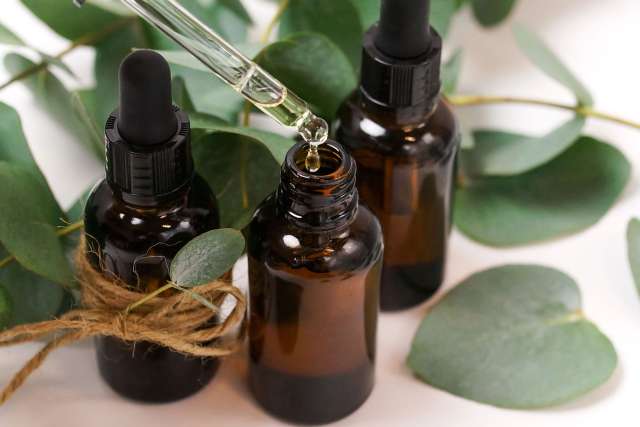For many people, the fragrant scent of essential oils derived from f lowers, trees or spices are a soothing balm to calm nerves and promote relaxation and wellbeing. A growing body of research now attests to the therapeutic value of these plant-derived elixirs. “Essential oils have made their way into mainstream practice,” says Elizabeth Ko, MD, medical director of the UCLA Health Integrative Medicine Collaborative. “And it begs the question of the larger practice of integrative medicine, which blends conventional medicine w it h t hese nonpha rmacolog ic, evidence-based practices, like essential oils, massage, yoga and acupuncture.”
What are essential oils?
Dr. Ko: “Essential oils are volatile liquid substances extracted from plants, usually flowers, herbs or trees. The liquid is extracted through steam distillation or by machine, and during that process, the fragrance is released, hence the word ‘aromatic.’ These oils are highly concentrated. For example, it takes about 220 pounds of lavender flowers to make one pound of essential oil. Essential oils are quickly absorbed by smell receptors that are linked to the limbic system, which controls heart rate, blood pressure, breathing and stress. Every plant has a different chemical makeup that affects its smell absorption and its effect.”
How are essential oils used?
Dr. Ko: “These potent plant oils can be inhaled directly — taking a whiff from the bottle or from a cotton ball or tissue drizzled with a couple of drops — or indirectly, through a diffuser that spreads atomized fragrance through the air. Diluted essential oils may also be used topically by adding a few drops to a carrier oil, such as a vegetable or nut oil, as is often done for aromatherapy massage. While essential oils are not regulated by the U.S. Food and Drug Administration, they are generally recognized as safe when used as recommended. Aromatherapy has a relatively low toxicity profile when administered by inhalation or dilute topical application. It is important to note that we do not ingest essential oils.”
What is the role of essential oils in the hospital setting?
Dr. Ko: “Units throughout our hospitals have sets of three essential oils — lavender, lemon and peppermint — that medical personnel can offer to patients. Members of our integrative therapy team provide patients with relaxation services that include aromatherapy with essential oils, guided meditation and breath work, gentle in-bed movement and Reiki, a light touch stress-reduction technique. Aromatherapy, which has been offered at UCLA Health for many years, may be the most accessible of the available relaxation modalities. Lavender oil appears to be the most popular in the hospital. Patients associate lavender with relaxation, and that’s why they tend to pick it more often. Lemon is more uplifting, while peppermint is invigorating.
How do essential oils affect people?
Dr. Ko: “The smell of lavender is familiar and calming to many, and it’s also the moststudied essential oil. Lavender interacts with the neurotransmitter GABA to help quiet the mind and the nervous system. Studies show that lavender oil can improve sleep quality and increase time spent in deep, slow-wave sleep. Another study suggests lavender may work as effectively as anti-anxiety medicines, such as Xanax or Ativan. I encourage my patients who have anxiety disorder or panic disorder to carry a vial of essential oil close at hand. When the temptation hits to pop a pill, I ask them to pause and take a deep breath with a touch of lavender oil. If it’s effective, then great. If they do need something more afterward, at least they tried a lower-risk, lower-cost intervention. Aromatherapy with bergamot essential oil, a type of citrus, also has been shown to ease feelings of anxiety and stress. Lemon oil, which smells like ripe fruit, has been found to boost mood. Peppermint oil, which has an eye-opening, bright scent, appears to increase memory and alertness.
“I encourage my patients who have anxiety disorder or panic disorder to carry a vial of essential oil close at hand. When the temptation hits to pop a pill, I ask them to pause and take a deep breath with a touch of lavender oil.”
What are some other popular oils?
Dr. Ko: “Cinnamon, chamomile, tea tree and eucalyptus, which one study found effective in reducing pain and inf lammation. When shopping for essential oils, I recommend that people look for formulations that are 100% pure. Beware of ultra-low prices, as pure oils generally cost at least $10 for a half-ounce bottle.
How long does it last?
Dr. Ko:“Effects from essential-oil aromatherapy tend to be short-lived. It’s not on the order of hours; probably more on the order of minutes. Still, a half-ounce bottle will likely last months, even with frequent use, since only a drop or two is needed to produce perceptible fragrance. With the variety, general safety and increasingly documented efficacy of essential oils, I suggest that those who a re cu r ious ta ke a n ex per i menta l approach to see what smells they like and what feelings are elicited. It can be a nice way to explore.”

